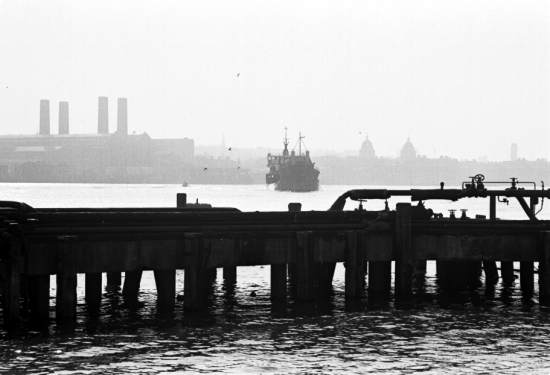It must be well over 18 months since I last went into the darkroom to make a black and white print. Until recently it wasn’t something I’d ruled out, just that I hadn’t had a need to do so.
I’ve now printed several shows in black and white using ink jet, including some quite important events – such as my exhibition for the 2005 FotoArtFestival in Beilsko-Biala, Poland, where I was chosen as the photographer to represent the United Kingdom. It can’t have been too disastrous, as I’m back there again in around ten days time, although this time giving a presentation rather than as an exhibitor (Mitri Tabrizian is batting for us this time.)

The work that I showed in Poland was from my London’s Industrial Heritage web site, taken in the late 1970’s and early 1980s, a kind of post-industrial landscape of London, largely based around the River Thames (but later extended to cover a wider area.)
Then I was printing using one of Jon Cone’s great Piezotone inksets, perhaps the first to really give great prints on fine-art matte papers, such as Hahnemuhle’s Photorag and German Etching. Few photographers really mastered printing on matte silver papers – George Krause is one of the few whose work has impressed me, although rather more have made fine matte prints using platinum – including the great masters of the medium, Frederick Evans and Dr Peter H Emerson. But using the Cone Piezography inksets (including the more recent K7 inks) makes it easy to acheive similar results.
A few years back, I had a platinum printer of some note come round to investigate making digital negatives for use in platinum printing. While he was here, I scanned one of his 4×5 negatives and made a Piezo print as well as the enlarged negative he wanted. It gave our meeting an uncomfortable end, as the print seemed to me considerably superior to the platinum he had previously made from an enlarge film negative.
Until around 18 months ago it was still clear that if you wanted really high quality glossy prints, the only way to produce them was in the darkroom. Then came the first generation of improved ‘fibre-base’ glossy inkjet materials, including Crane Museo Silver Rag, Innova F-Type FibaPrint and Hahnemuhle Fine Art Pearl, (and also their re-packaged equivalents, DaVinci Fibre Gloss Classic and Permajet Classic Fine Art Fibre Base Gloss.) These gave colour prints that more than matched those on the plastic RA4 colour papers, and black and whites that were hard to distinguish at least from run of the mill silver prints, although still perhaps a little lacking when compared to the best the current darkroom has to offer – and certainly inferior to the Holy Grail of the old formula Cadmium ridden and highly environmentally friendly Agfa Record Rapid of blessed memory.
Now we have a second generation of fibre-base inkjet papers, so far including Harmon’s Gloss FB Al, Hahnemuhle’s Fine Art Baryt and, perhaps most interesting, the first such paper from an inkjet printer manufacturer, Epson’s Exhibition Fiber, available from next month. So far all I’ve been able to do is read the reviews, such as this on Luminous Light.
I’m already thinking what I can do with my darkroom. At the moment the most likely use is storage for all those Terabyte disk arrays I’m going to need for the incredible amount of digital files I’m currently shooting on the D200 for ‘My London Diary.’